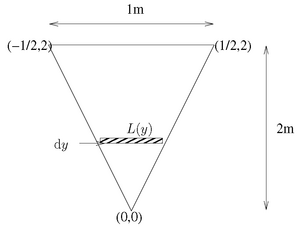Science:Math Exam Resources/Courses/MATH101/April 2009/Question 07 (a)/Solution 1
Hydrostatic Force was not covered in the 2012 offering of this course. Time might better be spent solving other problems given how soon the exam is coming.
Consider the triangular side pictured to the right

. It has height 2 and length 1. Also consider a little rectangular sliver in the picture of length L(y) and height dy. The reason we consider rectangular pieces with constant height is because the pressure depends on height and so we would like the effect from height to be the same on any given rectangular piece. We will use the labelling in the diagram with the bottom vertex being (0,0), the right vertex being (1/2,2) and the left vertex being (-1/2,2). With our origin at the bottom, we will label y from there. This means that the height (as measured from the top of the surface) is (2-y). We then have that the force on any given rectangle, dF, is,
We could then get the total force by integrating dF but first we need an expression for the length in terms of the height, y. The length of any rectangle will start at the left edge of the triangle and end at the right edge. We can use the coordinates that we listed to find equations for these lines. The right edge is given by
which written in terms of y is,
where we have added a subscript R to indicate it's the right edge. Notice we compute the line by finding the slope using the right vertex and bottom vertex and then notice that the line goes through our origin to its y-intercept is zero. We can similarly get that the left edge is
This can also be argued with symmetry of the right edge. We then have that
Therefore we can now get F via integration where we see that y starts at zero and ends at y=2. Therefore,
We are told in the problem that the density is 1000kg/m^3 and we take the gravitational constant as 9.8N/kg. Therefore,
This is the hydrostatic force on each of the triangular sides.






